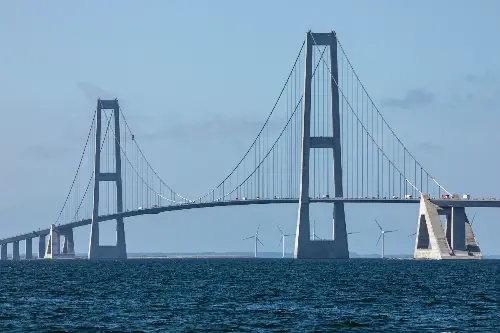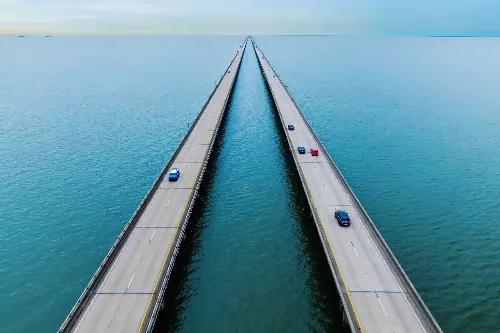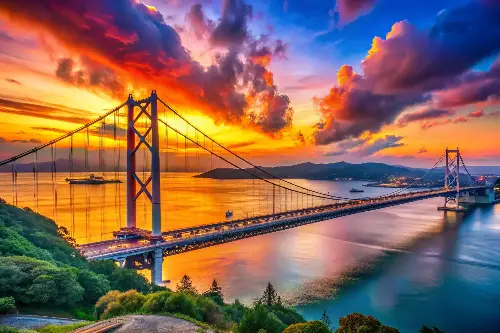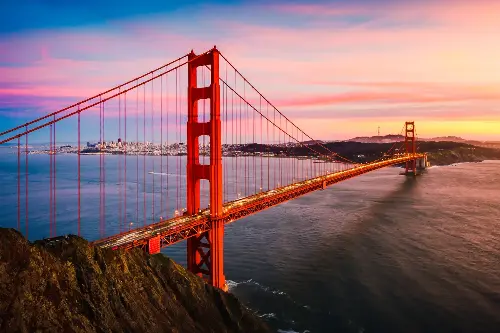As we cross vast expanses of water, it is easy to overlook the marvels of engineering that make such journeys possible. The Danyang–Kunshan Grand Bridge in China is a testament to human ingenuity, holding the title of the longest bridge in the world. Stretching over an incredible 164.8 kilometres, this feat of architecture is part of the Beijing-Shanghai High-Speed Railway. The bridge took four years to construct, involving thousands of engineers and workers, and it was completed in 2010. The Danyang–Kunshan passes over low-lying lands and waters in the Yangtze River Delta with a series of viaducts and spans, creating a seamless route that minimises travel time between two major cities, reshaping the economic and social landscape of the region.
Engineering Marvels of the Great Belt Fixed Link

Denmark's Great Belt Fixed Link, another architectural masterpiece, serves as a critical artery connecting the Danish islands of Zealand and Funen. With its completion in 1998, this multi-faceted project comprised of a road suspension bridge, a railway tunnel, and a box girder bridge, is one of the most complex bridge systems in the world. The suspension bridge segment, known as the East Bridge, prominently features a 1.6-kilometre span between its towers, which are as tall as some skyscrapers. It remains the third-longest suspension bridge span and supports the infrastructure needed for both heavy rail and road traffic, uniting regions and boosting opportunities for trade and travel.
Frameworks Rising from the Sea: Lake Pontchartrain Causeway

The Lake Pontchartrain Causeway in the United States once held the title for the longest bridge over water (continuous), stretching nearly 38 kilometres across Lake Pontchartrain in Louisiana. Composed of two parallel bridges, this structure is a daily passage for commuters and a crucial link for local economies. Its construction dates back to the 1950s, with the southbound bridge opening in 1956 and the northbound in 1969. The causeway is a straightforward design, a testament to the utilitarian approach to bridge engineering, prioritising function over form. Despite its simple aesthetics, the bridge's length and the challenges in maintaining such a long structure have ensured its place in the pantheon of modern architectural wonders.
Akashi Kaikyō Bridge: Embracing Innovation

The Akashi Kaikyō Bridge in Japan represents a bold step into architectural modernity. Also known as the Pearl Bridge, it is world-renowned for having the longest central span of any suspension bridge, extending 1,991 metres. Before its completion in 1998, ferries were the main means of crossing the Akashi Strait. However, the severe storm in 1955 led to a tragic accident involving two ferries, prompting the Japanese government to consider the construction of a bridge. The Akashi Kaikyō Bridge not only revolutionised travel between the city of Kobe and Awaji Island but also incorporated cutting-edge technology to withstand earthquakes and harsh sea conditions, symbolising Japan's resilience and technological advancements.
The Awe-Inspiring Qingdao Haiwan Bridge

China's Qingdao Haiwan Bridge, another architectural giant, showcases the rapid progress of modern engineering and infrastructure. When it opened in 2011, it became the world's longest bridge over water (aggregate length), stretching over 41.58 kilometres. This bridge was constructed to reduce travel time between Qingdao and Huangdao by more than half, transforming the local landscape for commuters and tourists alike. Remarkably, the project was completed in just four years and incorporated environmental safeguards to protect the rich marine life below. Its enduring structure, supporting thousands of vehicles daily, serves as a visual noter of China's economic boom and ambition.
Iconic Design and Cultural Significance: The Golden Gate Bridge

While other bridges may surpass its length, San Francisco's Golden Gate Bridge remains one of the most iconic architectural feats worldwide. Opened in 1937, this bridge spans 2.7 kilometres across the Golden Gate strait and is a marvel of Art Deco design and transformative engineering. Not only did it achieve the title of the world's longest and tallest suspension bridge at the time of its completion, but it also became an emblem of hope during the Great Depression. Thousands of men found employment during its construction, and the finished bridge symbolised America's tenacity and innovation, an enduring image in the landscape of American culture.
Sailing into the Future: New Bridge Projects on the Horizon
As we marvel at the current wonders of bridge construction, it's thrilling to anticipate what the future holds. From China's ongoing endeavours to the ambitious plans of other nations, the race to create longer, safer, and more aesthetically pleasing bridges continues. New materials and technologies, such as carbon fibre composites and advanced seismic designs, promise to elevate our ability to span even greater distances. As we bridge the gaps between communities, these architectural wonders are not just triumphs of design and engineering; they are connectors that bring us closer together, symbolising our unending quest to overcome physical boundaries and foster global unity.
In conclusion, while each of these bridges serves a functional purpose, their larger relevance lies in the stories they tell—of innovation, ambition, and the unyielding human spirit. As we look upon these structures, whether we are daily commuters or awestruck tourists, we are reminded of what we can accomplish when creativity and determination come together. Our journey to connect the world is unceasing, and these bridges stand as milestones along that path, leading us towards a more integrated and accessible world.
